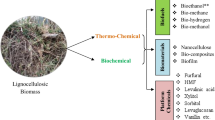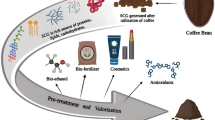Abstract
Purpose
The energy crisis is an eminent problem that needs to be dealt with urgently. Thus, alternative routes for the production of biofuels are sought. This paper investigated experimentally the possibility of biodiesel and bioethanol production from spent coffee grounds (SCG), aiming at the same time to manage an emerging waste stream.
Methods
SCG have oil and cellulose contents of 12.89% and 9.87%, respectively that may be valorized accordingly. Having chosen the Soxhlet method as an extraction method for oils and fats and by examining two different solvents: methanol as a polar compound and hexane as a nonpolar, the effect of the Soxhlet extraction cycles (time of experiment) and the ratio of solvent to raw material was studied. Furthermore, enzymatic saccharification and alcoholic fermentation were chosen as the means to valorise cellulose.
Results
It was proved that hexane is a more efficient solvent with oil extraction yields ranging from 73.15 to 97.21%. The highest yield was obtained for 20 extraction cycles and solvent to raw material ratio equal to 20. As far as enzymatic hydrolysis is concerned, the maximum saccharification yield for SCG was 44.20% which was achieved under the following conditions: NaOH 0.3 M and CellicCTec2 75 µL/g cellulose.
Conclusion
It is thus technically feasible to recover and extract the oil content from spent coffee grounds as well as to achieve moderate saccharification yields and to this direction an integrated biorefinery was proposed. Estimating the potential of SCG as feedstock for biodiesel and bioethanol production at global level, it was evident that SCG can contribute to the energy strategy through biofuels promotion.
Graphic Abstract



Similar content being viewed by others
References
Martinez-Saez, N., García, A.T., Pérez, I.D., Rebollo-Hernanz, M., Mesías, M., Morales, F.J., Martín-Cabrejas, M.A., del Castillo, M.D.: Use of spent coffee grounds as food ingredient in bakery products. Food Chem. 216, 114–122 (2017). https://doi.org/10.1016/j.foodchem.2016.07.173
International Coffee Organisation: Coffee market report: July 2019. (2019)
Peshev, D., Mitev, D., Peeva, L., Peev, G.: Valorization of spent coffee grounds—a new approach. Sep. Purif. Technol. 192, 271–277 (2018). https://doi.org/10.1016/j.seppur.2017.10.021
Caetano, N.S., Silvaa, V.F.M., Mata, T.M.: Valorization of coffee grounds for biodiesel production. Chem. Eng. Trans. 26, 267–272 (2012). https://doi.org/10.3303/CET1226045
Vardon, D.R., Moser, B.R., Zheng, W., Witkin, K., Evangelista, R.L., Strathmann, T.J., Rajagopalan, K., Sharma, B.K.: Complete utilization of spent coffee grounds to produce biodiesel, bio-oil, and biochar. ACS Sustain. Chem. Eng. 1, 1286–1294 (2013). https://doi.org/10.1021/sc400145w
Tuntiwiwattanapun, N., Usapein, P., Tongcumpou, C.: The energy usage and environmental impact assessment of spent coffee grounds biodiesel production by an in-situ transesterification process. Energy Sustain. Dev. 40, 50–58 (2017)
Blinova, L., Bartosova, A., Sirotiak, M.: Biodiesel production from spent coffee grounds. Res. Pap. Faculty Mater. Sci. Technol. Slovak Univ. Technol. 25, 113–121 (2017). https://doi.org/10.1515/rput-2017-0013
Swanepoel, W., Karmee, S.K., Marx, S.: Biocatalytic production of biodiesel from spent coffee grounds. Environment 1, 2 (2016)
Aarthy, M., Saravanan, P., Gowthaman, M.K., Rose, C., Kamini, N.R.: Enzymatic transesterification for production of biodiesel using yeast lipases: an overview. Chem. Eng. Res. Des. 92, 1591–1601 (2014). https://doi.org/10.1016/j.cherd.2014.04.008
Haile, M.: Integrated volarization of spent coffee grounds to biofuels. Biofuel Res. J. 1, 65–69 (2014). https://doi.org/10.18331/BRJ2015.1.2.6
Kwon, E.E., Yi, H., Jeon, Y.J.: Sequential co-production of biodiesel and bioethanol with spent coffee grounds. Bioresour. Technol. 136, 475–480 (2013). https://doi.org/10.1016/j.biortech.2013.03.052
Shi, A., Du, Z., Ma, X., Cheng, Y., Min, M., Deng, S., Chen, P., Li, D., Ruan, R.: Production and evaluation of biodiesel and bioethanol from high oil corn using three processing routes. Bioresour. Technol. 128, 100–106 (2013). https://doi.org/10.1016/j.biortech.2012.10.007
Kovalcik, A., Obruca, S., Marova, I.: Valorization of spent coffee grounds: a review. Food Bioprod. Process. 110, 104–119 (2018). https://doi.org/10.1016/j.fbp.2018.05.002
Allen, T.T.: Introduction to Engineering Statistics and Six Sigma. Springer, Colombus (2007)
Li, S.Z., Jain, A.: (eds.) Fisher criterion. In: Encyclopedia of Biometrics. pp. 549–549. Springer, Boston (2009)
Sluiter, A., Hames, B., Ruiz, R., Scarlata, C., Sluiter, J., Templeton, D., Crocker, D.: Determination of structural carbohydrates and lignin in biomass: Laboratory Analytical Procedure (LAP) (NREL/TP-510–42618). Natl. Renew. Energy Lab. 17 (2012)
McNutt, J., He, Q.: Spent coffee grounds: a review on current utilization. J. Ind. Eng. Chem. 71, 78–88 (2019). https://doi.org/10.1016/j.jiec.2018.11.054
Ballesteros, L.F., Teixeira, J.A., Mussatto, S.I.: Chemical, functional, and structural properties of spent coffee grounds and coffee silverskin. Food Bioprocess Technol. 7, 3493–3503 (2014). https://doi.org/10.1007/s11947-014-1349-z
Atabani, A.E., Al-Muhtaseb, A.H., Kumar, G., Saratale, G.D., Aslam, M., Khan, H.A., Said, Z., Mahmoud, E.: Valorization of spent coffee grounds into biofuels and value-added products: pathway towards integrated bio-refinery. Fuel 254, 115640 (2019). https://doi.org/10.1016/j.fuel.2019.115640
Al-Hamamre, Z., Foerster, S., Hartmann, F., Kröger, M., Kaltschmitt, M.: Oil extracted from spent coffee grounds as a renewable source for fatty acid methyl ester manufacturing. Fuel 96, 70–76 (2012). https://doi.org/10.1016/j.fuel.2012.01.023
De Melo, M.M.R., Barbosa, H.M.A., Passos, C.P., Silva, C.M.: Supercritical fluid extraction of spent coffee grounds: measurement of extraction curves, oil characterization and economic analysis. J. Supercrit. Fluids. 86, 150–159 (2014). https://doi.org/10.1016/j.supflu.2013.12.016
Yordanov, D., Mustafa, Z., Milina, R., Tsonev, Z.: Multi-criteria optimisation process of the oil extraction from spent coffee ground by various solvents. Oxid. Commun. 39, 1478–1487 (2016)
Low, J.H., Rahman, W.A.W.A., Jamaluddin, J.: The influence of extraction parameters on spent coffee grounds as a renewable tannin resource. J. Clean. Prod. 101, 222–228 (2015). https://doi.org/10.1016/j.jclepro.2015.03.094
Mussatto, S.I., Dragone, G., Guimarães, P.M.R., Silva, J.P.A., Carneiro, L.M., Roberto, I.C., Vicente, A., Domingues, L., Teixeira, J.A.: Technological trends, global market, and challenges of bio-ethanol production. Biotechnol. Adv. 28, 817–830 (2010). https://doi.org/10.1016/j.biotechadv.2010.07.001
Mussatto, S.I., Machado, E.M.S., Martins, S., Teixeira, J.A.: Production, composition, and application of coffee and its industrial residues. Food Bioprocess Technol. 4, 661–672 (2011). https://doi.org/10.1007/s11947-011-0565-z
Efthymiopoulos, I., Hellier, P., Ladommatos, N., Russo-Profili, A., Eveleigh, A., Aliev, A., Kay, A., Mills-Lamptey, B.: Influence of solvent selection and extraction temperature on yield and composition of lipids extracted from spent coffee grounds. Ind. Crops Prod. 119, 49–56 (2018). https://doi.org/10.1016/j.indcrop.2018.04.008
Crisafulli, P., Navarini, L., Silizio, F., Pallavicini, A., Illy, A.: Ultrastructural characterization of oil bodies in different coffea species. Trop. Plant Biol. 7, 1–12 (2014). https://doi.org/10.1007/s12042-013-9132-2
Pichai, E., Krit, S.: Optimization of solid-to-solvent ratio and time for oil extraction process from spent coffee grounds using response surface methodology. ARPN J. Eng. Appl. Sci. 10, 7049–7052 (2015)
Kondamudi, N., Mohapatra, S.K., Misra, M.: Spent coffee grounds as a versatile source of green energy. J. Agric. Food Chem. 56, 11757–11760 (2008). https://doi.org/10.1021/jf802487s
Jenkins, R.W., Stageman, N.E., Fortune, C.M., Chuck, C.J.: Effect of the type of bean, processing, and geographical location on the biodiesel produced from waste coffee grounds. Energy Fuels 28, 1166–1174 (2014). https://doi.org/10.1021/ef4022976
Oliveira, L.S., Franca, A.S., Camargos, R.R.S., Ferraz, V.P.: Coffee oil as a potential feedstock for biodiesel production. Bioresour. Technol. 99, 3244–3250 (2008). https://doi.org/10.1016/j.biortech.2007.05.074
Andrade, K.S., Gonalvez, R.T., Maraschin, M., Ribeiro-Do-Valle, R.M., Martínez, J., Ferreira, S.R.S.: Supercritical fluid extraction from spent coffee grounds and coffee husks: antioxidant activity and effect of operational variables on extract composition. Talanta 88, 544–552 (2012). https://doi.org/10.1016/j.talanta.2011.11.031
Cholakov, G., Toteva, V., Nikolov, R., Uzunova, S., Yanev, S.: Extracts from coffee by-products as potential raw materials for fuel additives and carbon adsorbents. J. Chem. Technol. Metall. 48, 497–504 (2013)
Alder, P., Markova, E.V., Granovsky, V.: The Design of Experiments to Find Optimal Conditions a Programmed Introduction to the Design of Experiments. Mir Publishers, Moscow (1975)
Cochran, W.G., Cox, G.M.: Experimental Designs. WIley, New York (1957)
Seidenfeld, T.: R. A. Fisher on the design of experiments and statistical estimation. 23–36 (1992). https://doi.org/10.1007/978-94-011-2856-8_2
Pacheco-Torgal, F., Diamanti, M.V., Nazari, A., Granqvist, C.-G.: Nanotechnology in Eco-efficient Construction. Woodhead Publishing Limited, Swaston (2013)
Selvamuthu, D., Das, D.: Introduction to Statistical Methods, Design of Experiments and Statistical Quality Control. Springer, Singapore (2018)
Cox, D.R., Reid, N.: The Theory of the Design of Experiments. Chapman & Hall CRC, New York (2000)
Deligiannis, A., Papazafeiropoulou, A., Anastopoulos, G., Zannikos, F.: Waste coffee grounds as an energy feedstock. In: Proceeding 3rd Int. CEMEPE SECOTOX Conf., pp. 617–622 (2011)
Kobelnilk, M., Fontanari, G.G., Cassimiro, D.L., Ribeiro, C.A., Crespi, M.S.: Thermal behavior of coffee oil (Robusta and Arabica species) (2014)
Hurtado-Benavides, A., Dorado, D.A., Sánchez-Camargo, A.D.P.: Study of the fatty acid profile and the aroma composition of oil obtained from roasted Colombian coffee beans by supercritical fluid extraction. J. Supercrit. Fluids. 113, 44–52 (2016). https://doi.org/10.1016/j.supflu.2016.03.008
Figueiredo, L.P., Borém, F.M., Ribeiro, F.C., Giomo, G.S., Taveira, J.D., Malta, M.R.: Fatty acid profiles and parameters of quality of specialty coffees produced in different Brazilian regions. African J. Agric. Res. 10, 3484–3493 (2015). https://doi.org/10.5897/ajar2015.9697
Romano, R., Santini, A., Le Grottaglie, L., Manzo, N., Visconti, A., Ritieni, A.: Identification markers based on fatty acid composition to differentiate between roasted Arabica and Canephora (Robusta) coffee varieties in mixtures. J. Food Compos. Anal. 35, 1–9 (2014). https://doi.org/10.1016/j.jfca.2014.04.001
Budryn, G., Nebesny, E., Zyzelewicz, D., Oracz, J., Miśkiewicz, K., Rosicka-Kaczmarek, J.: Influence of roasting conditions on fatty acids and oxidative changes of Robusta coffee oil. Eur. J. Lipid Sci. Technol. 114, 1052–1061 (2012). https://doi.org/10.1002/ejlt.201100324
Wongsiridetchai, C., Chiangkham, W., Khlaihiran, N., Sawangwan, T., Wongwathanarat, P., Charoenrat, T., Chantorn, S.: Alkaline pretreatment of spent coffee grounds for oligosaccharides production by mannanase from Bacillus sp. GA2(1). Agric. Nat. Resour. 52, 222–227 (2018). https://doi.org/10.1016/j.anres.2018.09.012
Iroba, K.L., Tabil, L.G., Dumonceaux, T., Baik, O.D.: Effect of alkaline pretreatment on chemical composition of lignocellulosic biomass using radio frequency heating. Biosyst. Eng. 116, 385–398 (2013). https://doi.org/10.1016/j.biosystemseng.2013.09.004
Kim, J.S., Lee, Y.Y., Kim, T.H.: A review on alkaline pretreatment technology for bioconversion of lignocellulosic biomass. Bioresour. Technol. 199, 42–48 (2016). https://doi.org/10.1016/j.biortech.2015.08.085
Procentese, A., Raganati, F., Navarini, L., Olivieri, G., Russo, M.E., Marzoccchella, A.: Coffee silverskin as a renewable resource to produce butanol and isopropanol. Chem. Eng. Trans. 64, 139–144 (2018). https://doi.org/10.3303/CET1864024
Girotto, F., Lavagnolo, M.C., Pivato, A.: Spent coffee grounds alkaline pre-treatment as biorefinery option to enhance their anaerobic digestion yield. Waste Biomass Valoriz. 9(12), 2565–3257 (2018)
De Laclos, H.F., Thiebaut, E., Saint-Joly, C.: Anaerobic digestion of residual municipal solid waste using biological-mechanical pre-treatment: the plant of Varennes Jarcy. Water Sci. Technol. 58, 1447–1452 (2008). https://doi.org/10.2166/wst.2008.519
Giwa, A., Adeyemi, I., Dindi, A., Lopez, C.G.B., Lopresto, C.G., Curcio, S., Chakraborty, S.: Techno-economic assessment of the sustainability of an integrated biorefinery from microalgae and Jatropha: a review and case study. Renew. Sustain. Energy Rev. 88, 239–257 (2018). https://doi.org/10.1016/j.rser.2018.02.032
Sarkar, N., Ghosh, S.K., Bannerjee, S., Aikat, K.: Bioethanol production from agricultural wastes: an overview. Renew. Energy. 37, 19–27 (2012). https://doi.org/10.1016/j.renene.2011.06.045
Paritosh, K., Yadav, M., Mathur, S., Balan, V., Liao, W., Pareek, N., Vivekanand, V.: Organic fraction of municipal solid waste: overview of treatment methodologies to enhance anaerobic biodegradability. Front. Energy Res. 6, 1–17 (2018). https://doi.org/10.3389/fenrg.2018.00075
Yang, F., Hanna, M.A., Sun, R.: Yang et al. 2012 Value added use crude glycerol. Biotechnol. Biofuels. 5, 1–10 (2012). https://doi.org/10.1177/0095244312462163
Massaya, J., Prates Pereira, A., Mills-Lamptey, B., Benjamin, J., Chuck, C.J.: Conceptualization of a spent coffee grounds biorefinery: a review of existing valorisation approaches. Food Bioprod. Process. 118, 149–166 (2019). https://doi.org/10.1016/j.fbp.2019.08.010
Moser, B.R.: Biodiesel production, properties, and feedstocks. Vitr. Cell. Dev. Biol.-Plant. 45, 229–266 (2009). https://doi.org/10.1007/s11627-009-9204-z
Author information
Authors and Affiliations
Corresponding author
Additional information
Publisher's Note
Springer Nature remains neutral with regard to jurisdictional claims in published maps and institutional affiliations.
Rights and permissions
About this article
Cite this article
Passadis, K., Fragoulis, V., Stoumpou, V. et al. Study of Valorisation Routes of Spent Coffee Grounds. Waste Biomass Valor 11, 5295–5306 (2020). https://doi.org/10.1007/s12649-020-01096-0
Received:
Accepted:
Published:
Issue Date:
DOI: https://doi.org/10.1007/s12649-020-01096-0




